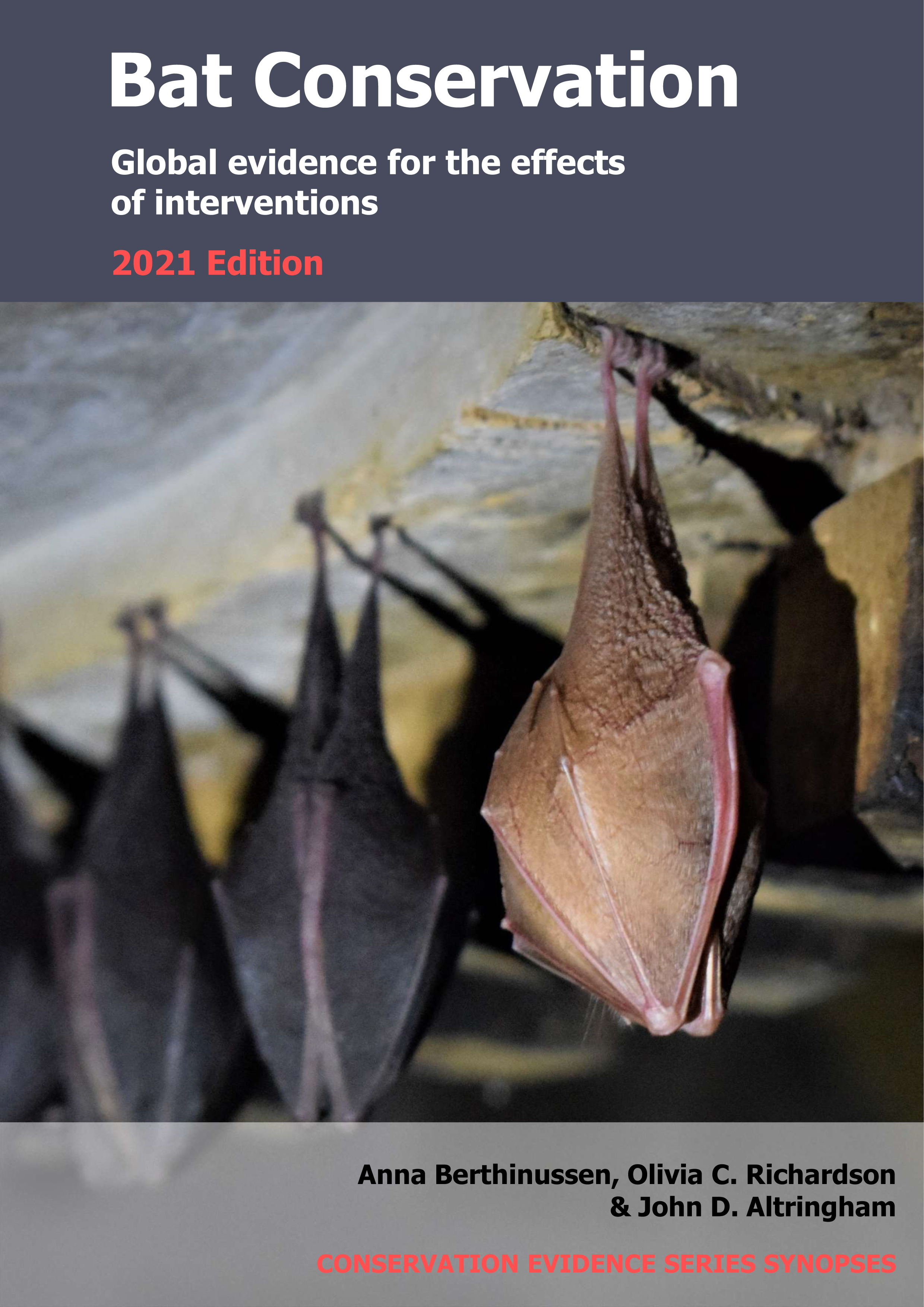Deter bats from turbines using ultrasound
-
Overall effectiveness category Unknown effectiveness (limited evidence)
-
Number of studies: 4
View assessment score
Hide assessment score
How is the evidence assessed?
-
Effectiveness
40% -
Certainty
35% -
Harms
10%
Study locations
Supporting evidence from individual studies
A paired sites study in 2007 on a wind farm in an agricultural area of New York, USA (Horn et al. 2008) found mixed effects on bat activity during two trials with an ultrasonic deterrent, and the deterrent did not have a significant effect overall. Fewer bats were observed over 10 consecutive nights at a turbine with an ultrasonic deterrent fitted (average 13 bat passes/night) than at a matched control turbine without a deterrent (average 24 bat passes/night). No significant difference was found in bat activity when this was repeated with a second matched pair (average 10 bat passes/night at both). The ultrasonic deterrent did not have a significant effect on the number of bats observed when results from both trials were combined (data reported as statistical model results). The deterrent broadcast random pulses of broadband ultrasound from 20–80 kHz. For both trials, bat activity was observed simultaneously at treatment and control turbines for 3.6 h after sunset for 10 consecutive nights in August 2007 using thermal infrared imaging cameras. Bats were not identified to species.
Study and other actions testedA replicated, randomized, controlled study in 2009–2010, with a before-and-after trial in the second year, at a wind farm in a forested area of Pennsylvania, USA (Arnett et al. 2013) found that an ultrasonic deterrent had mixed effects on bat mortality. In 2009, 21–51% fewer bats overall were killed per deterrent turbine (average 6 bats killed/turbine) than control turbine (average 9 bats killed/turbine). The difference in mortality was significant for hoary bats Lasiurus cinereus (deterrent: average 4 bats killed/turbine; control: 2 bats killed/turbine), but not for five other bat species (see original paper for data). In the 2010 before-and-after trial, between 2% more and 64% fewer bats were killed overall at deterrent turbines than at control turbines when accounting for differences found between control and deterrent turbines in the ‘before’ trial. Differences for individual species were not tested for statistical significance due to low numbers (see original paper for data). In 2009 and 2010, 10 randomly selected wind turbines were fitted with deterrent devices, and 15 randomly selected turbines without the device were used as controls. The deterrent emitted continuous ultrasonic broadband noise at 20–100 kHz. In 2009, daily carcass searches were conducted in August–October. In 2010, the before-and-after trial was conducted with daily carcass searches in May–July before the deterrent was used, followed by daily searches in July–October with the deterrent active. Carcass counts were adjusted to account for searcher efficiency and removal by scavengers.
Study and other actions testedA replicated, randomized, controlled study in 2014–2016 at a wind farm in a forested area of Illinois, USA (Romano et al 2019) found that turbines with ultrasonic deterrents emitting a constant or pulsed signal had mixed effects on bat mortality. Turbines with ultrasonic deterrents emitting a constant signal had 26–36% fewer hoary bat Lasiurus cinereus fatalities compared to turbines with no deterrent (data reported as statistical model results). For silver-haired bats Lasionycteris noctivagans and eastern red bats Lasiurus borealis, there were significantly fewer fatalities (57% and 39% respectively) during one of two years of the study with the constant signal deterrent. Turbines with deterrents emitting a pulsed signal had 73% fewer fatalities of silver-haired bats, but the difference was not significant for hoary bats or eastern red bats. Five other bat species or species groups were identified during carcass searches, although numbers were too low for statistical analysis (see original paper for data). In each of three years, nine or 10 six-day trials were carried out at 12–16 randomly selected turbines (half with deterrents fitted). Deterrents were switched between turbines halfway through each trial. Air-jet ultrasonic deterrents emitted sounds at 30–100 kHz between 1800 and 0630 h. Constant signals were used in 2014 and 2015 and pulsed signals in 2016 (5–8 second duration at 3 second intervals). Transects within a 60-m radius around each turbine were searched daily for bat carcasses during each trial in August–October 2014–2016. Carcass counts were adjusted to account for searcher efficiency and removal by scavengers.
Study and other actions testedA replicated, randomized, controlled study in 2017–2018 at a wind energy facility in an area of dry shrubland in Texas, USA (Weaver 2019) found that using ultrasonic deterrents on turbines reduced the number of fatalities of hoary bats Lasiurus cinereus and Brazilian free-tailed bats Tadarida brasiliensis but not northern yellow bats Lasiurus intermedius. On average, fewer bat carcasses were found at turbines with active ultrasonic deterrents than at those with inactive deterrents for hoary bats (active: 0.006 carcasses/night; inactive: 0.029 carcasses/night) and Brazilian free-tailed bats (active: 0.119 carcasses/night; inactive: 0.261 carcasses/night). The difference was not significant for northern yellow bats (active: 0.016 carcasses/night; inactive: 0.020 carcasses/night). Ultrasonic deterrents (arrays of 5–6 speakers emitting continuous sounds at 20–50 kHz) were installed on the nacelles of 16 wind turbines. During each night in July–October 2017 and 2018, eight randomly selected turbines had ‘active’ ultrasonic deterrents (turned on), and eight control turbines had ‘inactive’ deterrents (turned off). Carcass searches were conducted daily along transects in circular plots (100-m radius) around each of the 16 turbines.
Study and other actions tested
Where has this evidence come from?
List of journals searched by synopsis
All the journals searched for all synopses
This Action forms part of the Action Synopsis:
Bat Conservation
Bat Conservation - Published 2021
Update 2020





)_2023.JPG)














